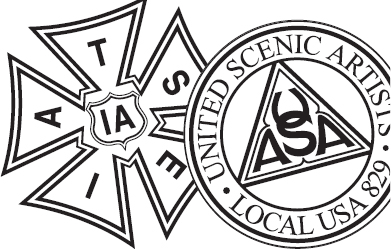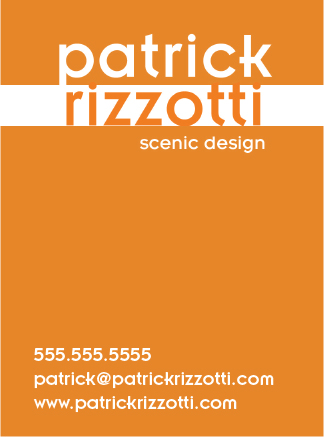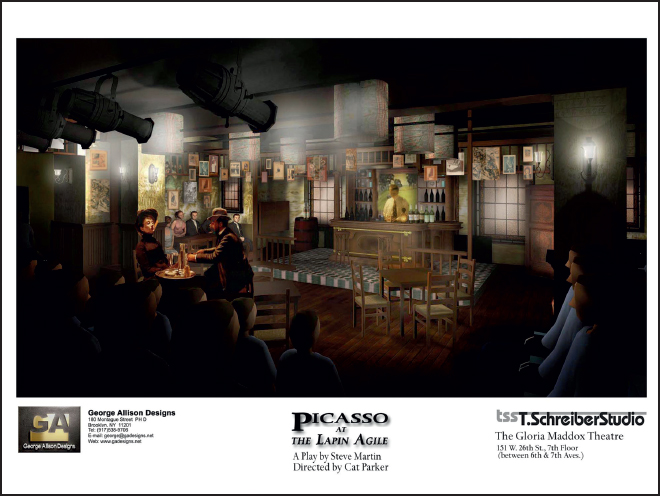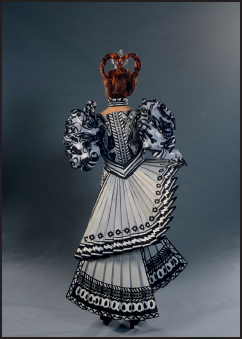OK, so now you’re a professional designer and artist, right? Well, not quite. You might now think you’re a designer, but that thought might be premature, and you probably shouldn’t jump the gun. The road to becoming a designer is a long one, and most practicing artists feel that road never ends.
You’re at the beginning of a journey. Problem is, you’ve likely picked up bad habits, like eating, keeping warm, and wearing clothes. You now either have to give up those habits, or consider that you’re also in business. Up until now the only business aspect of thatre discussed here has been the producer selling tickets.
You’re training as a designer, using good design practices to create art. Many designers are also artists, but art and design are not the same thing. You can design and not create art, but good art seldom works without good design. We are not hired to create whatever we want in any way we want, we are hired to do a specific job with very specific parameters. Deadlines and details — miss one and you fail, period.
Now, let’s get to work. We are business people in the design business, and we must be able to conduct ourselves in a professional manner if we are to get paid. Getting paid for our work is the essence of the professional.
Theatre is a business. It’s called Show Business for a reason.
There are few regular jobs in the business of show, at least in the way there are jobs in many other careers. Odds are that even if you have stints with a major studio, a regional theatre, or work strictly union gigs, you will still have a freelance career, especially as a designer.
Odds are very much against you going straight from graduation to the top of the profession. It has happened, but only rarely. Even if that does happen, talent, knowledge and opportunity have to align perfectly. In most cases graduation is the beginning of a new journey. A long journey, but a potentially rewarding journey.
Show business is the business of building entertainment.
To get to Broadway, Disney, Cirque, Sony, Amazon, or CBS, you climb the ladder, starting at the bottom. This is the next step in your education.
It is critical to leave school with skills you can market and sell. A young set designer is unlikely to get a Broadway design gig right away, but there is work as an assistant, a PA, a scenic painter, props artisan, or carpenter. These jobs help make connections while also providing a way to earn a living.
Accept and embrace these facts. It’s a cool lifestyle.
There are many books that will tell you how to find work or make sales. This really isn’t one of those books. Like so much in our profession, getting work is a career long process. Hopefully we all reach a point where the work just comes.
In the meantime, getting work is about interviewing and networking. The person at the next desk is likely to be someone you work with as long as you both remain in the business. Our world is very small. You will encounter the same people over and over again, so treat all the people you encounter accordingly. The same will be true of the friends you make working in summer stock.
Those connections are the most important reason you must work in the business when on breaks from school. The other most important reason will be to refine your skills and make connections.
Presentation is critical in getting and interviewing for work. Sound familiar? Stand straight, speak clearly, address questions honestly. Be forthright.
Just like when you present your design ideas.
Labor Unions or Guilds are groups of people working together for their greater good, and the greater good of society as a whole. Unions pursue collective workplace goals: wages, benefits, and work rules are some of the obvious areas for negotiation with management, or the producer.
Unions generally benefit consumers as much as workers by ensuring the goods produced and the services provided are of good quality.
Labor unions are descended from Medieval Guilds, where craftsmen (they were men only at that time) formed associations based on their trades. Carpenters, textile workers, masons, carvers, glass workers, and painters unified to control the secrets, arts, or mysteries of their crafts.
In contemporary society we owe things like the 40-hour work week, the 8-hour work day, weekends, holidays, and benefits to the unions.
Generally speaking, design professionals in the entertainment industries belong to the International Alliance of Theatrical Stage Employees or IATSE (pronounced eye-at-see). Often simply just the IA.

There are many different locals, some based on specialty, some based on location, usually due to the amount and types of work done in any specific place.
Union membership is based on qualifications, and is a goal for every designer. Being accepted into a union local indicates you have a breadth of experience and a level of ability.
A union will not get you work, but being a member will allow you to get better work, under better working conditions.
For designers there are three important locals.
The United Scenic Artists Local 829 is a national local representing designers for theatre across the country and designers working in film and television outside of the Los Angeles area.
In LA, Local 800; the Art Directors Guild represents production designers, art directors and the like working in film and television. Local 892; the Costume Designers Guild represents costume designers, assistants and illustrators also working in Hollywood.
Some designers are members of more than one local. Sometimes that might mean multiple design locals, or a craft local and a design local.
Refine and hone your skills, don’t settle for mediocre work.
Since we have established that you’ll likely not be designing on Broadway when you graduate, what can you do? You still have that whole eating thing to pay for every day.
The business and the work is like a triangle. If the designer is at the top, then there are assistants, and craftspeople below. That’s not judgmental in any way, that’s about the need for quantity of people. Every one designer will usually rely on multiple assistants/staff and then a multitude of artisans.
What industry related skills do you have that you can use to find paying work while you’re grabbing every opportunity you can to design?
Design opportunities like small theatrical productions, or indie film are great places to practice your art and craft. They are also great places to network and build a reputation. They probably do not pay much but there are rewards.
Here’s where your crazy good drafting, scenic painting, prop finding/building, electrical, programming, editing, tailoring, stitching skills come into play. These skills are widely needed, and are the gateways to getting on a commercial set, a feature, a regional theatrical production, or a cruise ship.
Working in a related craft or technical field is a way to meet designers you might eventually assist. These can be stepping stones, or you might find a place, other than as a designer, where you can have a happy and successful career. If thinking of a technical position as a stepping stone, do not stay there too long, you can find yourself pigeon holed into that role.
Pay rates will vary by job, region, city, and whether the work is in film, theatre, television, or rock and roll. This is where your network comes into play if you are not working under a union jurisdiction. You can do over hire union work before you join.
Do not undersell yourself. You can’t oversell, a producer won’t over pay. Ask your colleagues about going rates, and don’t undercut them. That’s a disservice to you and them. It will not help you advance your career if you cause everyone’s pay to drop.
Where are you willing to work? Where do you want to work? Where do you want to live?
If you want to work on Broadway, it’s probably best to move to New York City.
If you’re serious about a career in show business, you had better make it your business to embrace a city where theatre, film and television is being made. New York, Los Angeles,
Show enthusiasm.
Las Vegas, Atlanta, Orlando, and Chicago are biggies.
Wherever you are, or wherever you go, find the theatres and studios, the equipment rental houses and the prop houses, the costume shops and fabric stores. Get to know your transportation options, and where to rent vans and trucks. Spend as much time around your city as you can to get really comfortable. This will go a long way in boosting your confidence, and making a big part of your job a whole lot easier. Most importantly, taking the initiative and scouting resources instantly differentiates you and makes you a valuable member of the production team.
Don’t under-charge.
Having an agent or agents won’t get you work.
Having a press agent, or publicist might, but you will have to have work for them to leverage in order for them to make your visible.
There are no weekends in show business.
An agent might be able to help get you involved in projects if they have a roster of people with different skills, like film editors, directors, directors of photography. In this scenario, the agent can try to leverage one hire in order to get the project or studio to hire others off of their roster, increasing the agent’s commission.
Generally, agents can handle negotiating, collecting fees, and some of the other less pleasant business activities required of a working designer.
No one likes the word, but it has to be here.
Your taxes are never going to be simple. You will need an accountant, as well as some basic accounting knowledge.Yes, you hate that, but you probably hate accounting less than going without indoor plumbing.
Learn about sales tax. You might be an amazing artist with light, but you might also earn some fast cash by lighting weddings. That might mean you will also be the lighting producer, charging the client a flat fee, plus sales tax, for the design, the crew, the trucking, and consumables. You might also need a corporation and insurance. Your crew may need to be on payroll, and you will have to deduct taxes. At least there are services for payroll. That simplifies life a little.
Maybe you had best take that accounting class. Accounting can help you budget projects and organize you finances to simplify your work with your accountant. Knowing how to use a spread sheet to create and manage budgets is an important skill. That’s true of designers, designer/producers, shop mangers, art directors, and many others in our profession.
What’s a kit?
Your kit is your gear; it’s what you use to do your work. In film and television, your kit is also an income stream. You can rent it to the show. That’s less true of theatre, but you’ll still need computers, measuring tools, art supplies, and other gear. The specifics will vary by discipline and where you are in your career. A kit is something that grows and changes over time.
When starting out, your kit might include a sewing machine, wrenches, or paintbrushes. Eventually, you might want to leave some of that kind of work for others.
No matter what we do in this business of show, we all need certain tools. A designer’s kit will certainly contain a laptop, an iPad, an iPhone, chargers, a notebook, and a binder for all the paper we still collect. Just because you have everything digitally doesn’t mean everyone else does. Be ready to deal with other people’s paper. Many of us communicate via drawing, so always have a notebook and pencil on you so that the on-set carp can explain how they are building something, or so that you can take notes for yourself while you’re out standing in a field on location far far away from a cell tower.
Additionally, have a note pad, at least three blue or black pens, mechanical pencils, extra leads, an eraser, sharpies, highlighters, post-it notes, a small scale ruler, and a flashlight. Scale rulers, drawing tools, gel books, scissors, these are all in a kit.
Add and subtract from your kit as needed for each show.
Know your kit and take care of it.
Take the time to think about what you need for your personal kit. As you progress in your career, your kit will change. Remember that we’re discussing your personal, portable kit. This always must be something that you can carry with you at all times, and in all situations. So, you might want to leave your favorite bandsaw out of your personal kit.

Eduardo Sicangco’s kit would include a variety of papers, paints and pencils.


Spend some time thinking about how you want to present yourself. Remember that whatever you put together and how you put yourself together are sometimes the only things that a potential employer will see and use to evaluate your ability.
How you dress for meetings, social events and interviews is presentation. People can and will make snap judgements based on your appearance. You should have a professional look.
It’s really important to understand how you are expected to dress. After you’ve got a few shows under your belt, you’ll know in general how to dress. Your wardrobe will vary with the work.
When you’re starting out, you might not know what is required. There’s an easy fix for that; ask. If you’re working backstage on a show, you’ll probably be expected to wear all black with soft soled shoes. If you’re working for the Golf Channel you may be shooting at a country club that has a course dress code. In any case, always remember to ask if there is a dress code. You don’t want your favorite t-shirt to be a problem.
Spend less than you earn.
Consider personal props like pens, portfolios, and accessories. Invest wisely; the look of success and the appearance of success begets success. As with paint brushes and art supplies, it is best to have one good item than many cheap things. Save up.
Your personal branding is the beginning of your marketing plan.
What is your color scheme? What font are you using for your name and title? Is it clean, simple, and easy to read? If your presentation is junked up, the person hiring is likely to move on to the next applicant.

All of Patrick Rizzotti’s presentation materials share the same Visual Language and Branding. This is his business card and his note card is at the right.
Producers are managing a lot of moving parts, and often need to make a lot of decisions quickly. Make it easy for them to hire you. Lay out your work in a clean, simple, easy-to-navigate way.
You are setting yourself up to work, and the more work you get, the more people you meet, the more experiences you collect, the more opportunities will present themselves.
Your business card should be clean and easy to read. Resist the urge to junk it up. In this era of over-done everything, a simple card with basic information stands out and speaks of professionalism. Your card is how people know you. Set up a professional e-mail for your work. An e-mail address that may have special meaning for you and your friends, may scream not-serious to producers.
If a producer wants you, they will call, text or e-mail. Don’t make them hunt to find your digits.
This was once called a cover letter. May still be if you are printing and sending resumes by snail mail.
Compose an introductory e-mail to send to producers when you are writing about a potential job. There are lots of examples, good and bad. For an introductory e-mail, keep it on the slightly formal side. Since you probably don’t know the receiver of your e-mail personally, it’s best to err on the side of appearing too formal, as you can always adjust your tone to be more casual, later. Take your cues from how the person replies to you, and correspond with them in kind.
A personal template that you can modify on the fly will help you to reply to an inquiry right away. So many opportunities are really fast moving, and your ability to respond quickly can be one of the things that gets you hired. Customize your e-mail to speak to what is needed for the job. Details and deadlines are present in everything we do.
Never forget that hand written thank-you notes are still appreciated after a meeting. Work on that penmanship. Follow-up is very important, whether by e-mail, or by hand, don’t forget to say thank you!
Especially when starting out, you may want more than one resume. You may be applying for more than one type of job
• Designer resume
• Assistant resume
• Craft resume
Use your letterhead as the basis for your resume. Send the file out as a PDF so the recipient sees the typography and layout as intended. Name the file so the recipient knows your name and what you do before they open the file. Also, you don’t want a producer to have to scan 50 files named resume.pdf to find yours.


The whole point of a resume is to get work. Your resume should be one page that quickly says who you are and invites a potential employer to interview you.
• Proofread.
• Don’t lie.
• If you performed multiple roles on a single show, only show one per resume.
• In western cultures, we read top to bottom, and left to right. Your name, title and contact information, nothing more, should be at the top.
• Group your work, generally shows, by the position you held. List:
• Show
• Director or your supervisor
• Producing organization or venue
• Location; city and state
• Year produced
Skills can be broken into sub-groups, but knowing that you are fluent in French might be important. Just as important as the consoles you can program, software skills, welding, pattern drafting, draping, or scuba diving.
Associations and Affiliations is an area on your resume where you can show related activities, and indicate if you are a union member.
Education will generally be of primary importance to a fellow alumni, or when applying for an academic position. Nonetheless, everyone does like to know if you have a degree.
Portfolio and References Available Upon Request is a fine way to anchor the page. Not including references lets you tailor references to the job and it also gives you an excuse to reach out to any reference and let them know a producer might call. Contacting and reconnecting with your references on a regular basis can lead to other gigs. Always ask before giving a person’s name as a reference.
You’re only as good as your last project
Always remember that with or without references, employers will likely look through where you’ve worked and with whom you’ve worked to see if there is someone they know who they can contact to get the low down on you and your work.
In almost every situation, the work that we do is temporal, so document your work. It is easy to let that go when pushing a deadline, but stick with it. This is a very visual business, so take advantage of our digital age and shoot enough to document your work, but not enough to look like you’re always on your phone.
Ultimately, you’ll want to get a real camera and/or ask if the production has hired a photographer. If there is professional phorographer, see if you can talk to them about using their images in your portfolio (with proper credit, of course).
File and archive your images. Make sure everything is backed-up on and off site.
This is your story. It should have a beginning, a middle, and an end. That’s true even if your portfolio will always grow and change as you do more work.
What does yours look like? Find the right balance of creativity and professionalism. It’s not enough to show well executed work. There are many, many people new to our business that have photos and write ups of their nice work. What’s missing?
A sense of professionalism. Find for yourself that balance. Find your way to say I’m talented, I’m skilled, and I will always arrive 15 minutes early for my call, with a proper personal kit, ready to get to work.
Curate your work. Not every project is an opus worthy of sharing, certainly not forever.
Open and close your presentation with your best work. This does not have to be your most recent work, but simply the best work. In between, have a reasonable amount of other work showing your range.
Obviously, you need a website, and you should have a portfolio on your iPhone and your iPad as well. If you also have a traditional portfolio book, here are a few points:
• Always show copies, not original artwork.
• Keep extra resumes in your portfolio.
• Use removable pages to organize the book for different interviews.
• Keep the book oriented in one direction.

Scenic Designer George Allison’s presentations could easily slip into his portfolio, physical or electronic.
Clean up your social media presence. Potential employers will probably do a a web search on you. You had a great time at that party, but don’t let that photo get in the way of getting a job. There are as many types of people who will hire you as there are types of jobs. What may be funny and interesting to one might be inappropriate, or offensive to another. Don’t leave it to chance, if you have to think about it, delete it. Going forward, if you have to think about it, don’t post it.
Structure your days.

Scenic Designer George Allison’s documents each project for use in his portfolio. With careful record keeping, he can tailor his portfolio to speak to the potential client.
As much fun as they are, limit the number of silly shots. One or two candids of you on set or stage can be a great window into your personality, but remember the purpose of your web presence is to get work. We have a ton of fun in this business of show, but it is a business, and we are professionals. Don’t be that person who perpetuates the flaky artist idea.
Deliver on the details of your portfolio. Do a simple write-up on each project. What am I looking at? Where was it produced? Who is the director, the designer, the writer, etc. Do not assume that because you are intimate with the work you spent months on, that the person viewing has a clue.
Carefully curate your portfolio. Find the one, two, or three images from the show that convey your talent, skill, and resourcefulness. Don’t assume anyone will scroll thorough 20 images of each and every production. It’s better to have fewer photos that focus on the actual work that you did. For better or worse, producers are going to look for something on your site that speaks to what they need.
So, you got the job, you will want to get paid. Ideally, that’s handled by the union contract, or a time card. Often you will need to invoice.
For many productions, you’ll be asked to provide certain information in order to get paid. A good way to keep this in order and to make sure you provide all the information the production requires, is to set up a simple invoice that you can modify. The Pages app has a number of invoice templates, find one that works, or that you can make work, and save it as a template for you.
Generally, your invoices should have the following information:
• Your name as you want it to appear on your check
• The address where you want your check sent
• The date of your invoice
• The name of the producer, production company and address.
• The name of the show
• Your position
• The days, dates and hours you worked
• The rate you agreed on for the show
• Expenses that you incurred (if relevant)
• Travel costs (if relevant)
• Your social security number
• A nice line at the bottom like Thank you for this opportunity, looking forward to working with you again.
Pay close attention to what information is required by each show. Different producers have different systems and requirements can vary. An invoice that is incorrect or missing information can result in your payment being delayed. Help the producer pay you in a timely manner by having a professional invoice ready to go.
Beat deadlines. Be better than your word, and always be fierce and fearless!
Remember, as comprehensive as we have tried to make this little book, it is just an introduction.
Good Luck!

Wonderland is an fresh look at Lewis Carroll’s Alice stories, with songs by Frank Wildhorn and Jack Murphy. Tony Award winning Costume Designer Susan Hilferty created the clothes for the original Broadway production.
A costume designer works with actors on a very intimate level.

Detail of the back of the costume. Photograph by Rob Harris

Karen Mason onstage as the Queen of Hearts. Photograph by Michal Daniel
The story is about a newly separated mother recently relocated to Queens, NY, who finds her elevator has taken her to Wonderland.
She began with research and sketching. Lots of both. For the Queen of Hearts, she looked at playing cards, queenly things like crowns, sashes, and gowns. She also studied the illustrations in Carroll’s original, handwritten manuscript.
Sir John Tenniel was the original illustrator for Lewis Carroll’s Alice in Wonderland, and Susan’s point of departure for her designs. His black and white line drawings would be the basis for the Act I clothes. Act II would add color, lots and lots of color. Susan would be creating a new world.
Comparing contemporary queens to how queens have been illustrated throughout history was essential in researching the Queen of Hearts. There needed to be a nod to the past but a grounding in modern fashion. It took dozens of sketches and iterations on paper to nail the look to build a muslin mock-up.
Then the real sculpting could begin.
Susan knew what details from the queen of hearts playing cards she wanted to use: the ruff, the Q, the heart, and the face. She did not know exactly how they would be incorporated, or in what size and scale.
Susan Hilferty tells stories with clothes she has sculpted.
The muslin could be used as a road map for the final costume construction. Once fitted to the actor, the garment could be used to address practical and artistic questions.
On the practical side, how the dress works, and how the actor will be able to move when wearing the garment are always primary concerns.
Artistically, once the garment is functional, drawing on the muslin and adding photo copies of details allowed the designer to sketch in three dimensions. Susan was literally able to sculpt the final design.
Of course, the first time the actor playing the Queen of Hearts, Karen Mason, saw her costume she burst into tears of joy. It happens.

Some of Susan Hilferty’s detailing. Photograph by Rob Harris.

One of Susan’s earliest sketches for the Queen of Hearts.
